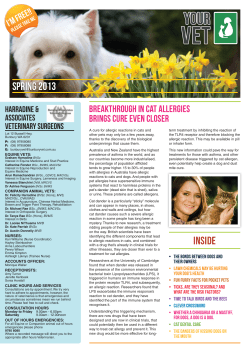
ABSTRACTS ISCFR 2012 EVSSAR 2012 7
Close this window to return to IVIS www.ivis.org ABSTRACTS ISCFR 2012 July 26‐29, Whistler, Canada th 7 International Symposium on Canine and Feline Reproduction In a joint meeting with EVSSAR 2012 15th Congress of the European Veterinary Society for Small Animal Reproduction Editors: Gary England, Michelle Kutzler, Pierre Comizzoli, Wojciech Nizanski, Tom Rijsselaere and Patrick Concannon Reprinted in IVIS with the permission of the ISCFR Organizers Reprinted in IVIS with the permission of the Organizers Close window to return to IVIS Contrast-enhanced ultrasonographic findings in canine prostatic and testicular disorders Russo, M1; Catone, G2 and England, GCW3 1 Obstetric Unit, Department of Veterinary Clinical Sciences, Veterinary School, University of Naples, Napoli, Italy; Department of Veterinary Clinical Sciences, Veterinary School, University of Camerino(MC),Italy and 3School of Veterinary Medicine and Science, University of Nottingham, Sutton Bonington, Leicestershire, UK 2 marco.russo@unina.it OBJECTIVES AND METHODS: Ultrasound is the most common imaging technique used for examination of the prostate gland and testes of the dog and has proven to be widely successful for diagnosis of many clinical conditions. Unfortunately the diagnosis of malignant prostatic and testicular diseases is challenging since benign and malignant lesions may, at least initially, have a similar clinical and imaging appearance. Recently, contrast-enhanced ultrasound (CEUS) has enabled measurement of vascular perfusion (essentially peak flow and transit time using video-densitometric analysis of real-time images) of parenchymous organs and our hypothesis is that CEUS may be useful for differentiating malignant from benign reproductive pathology in dogs. In this work we document the development of the CEUS technique for imaging the dog’s reproductive tract and detail some of our work to date in this exciting area. In clinical studies we have characterized prostatic and testicular diseases using CEUS and evaluated the perfusion kinetics in dogs without prostatic and testicular abnormalities and those with histologically confirmed benign or malignant prostatic and testicular disease. Ten dogs without prostatic abnormalities (mean age of 2.2 + 0.9 SD years and weighing between 6 and 37 kg), 26 dogs with prostatic disease (mean age of 9.3 + 2.3 SD years and weighing between 7.5 and 43.0 kg), and 30 dogs with scrotal abnormalities (mean age of 10.8 ± 2.9 SD years and weighing between 8 and 40 kg) were included in this study. Ethical approval for the study was gained through the normal procedure of the University of Naples. Considerable work was needed to develop methodology which we have previously reported (Russo et al., 2009; Vignoli et al. 2011). All CEUS examinations were performed using a MyLab 30 Gold (Esaote, Italy), with either a 5-3.5 MHz convex probe used for the prostate or a 9-2 MHz linear probe for the testes. A second-generation contrast agent, ulphur hexafluoride microbubbles (SonoVue , Bracco Imaging, Italy) and a dedicated contrast-enhanced ultrasound analytical software (Contrast Tuned Imaging Technology, Esaote, Italy). For the prostate vascular flow was measured including peak perfusion intensity (PPI) expressed as a percentage, and the time to peak (TTP) expressed in seconds. For the testes measures included relative blood volume (RBV), relative blood flow (RBF) and mean transit time (MTT). RESULTS: Careful attention to imaging equipment, technique and information processing was needed to produce reliable and valid results; we have shown that our methods can be effectively performed without adverse effects. Prostate. Various pathologies were found in the 26 abnormal prostates (11 benign prostatic hyperplasia, 1 prostatitis, 4 adenocarcinoma, 1 leiomyosarcoma and 9 mixed benign pathology). For normal dogs, PPI was a mean of 16.8 % (+ 5.8 SD) with a median of 17.80 %. The mean TTP was 33.6 + 6.4 s with a median of 34 s. For dogs with benign conditions there were no statistical differences to values for the normal dogs. For benign prostatic hyperplasia the PPI was a mean of 16.9 + 3.8 % (median 15.8%) and the TTP was a mean of 26.2 + 5.8 s (median 24.4 s). For mixed benign pathology the PPI was a mean of 14.8 + 7.8% (median 12.2%) and the TTP was a mean of 31.9 + 9.7 s (median 32.8 s); for prostatitis the PPI was 14.2% and the TTP was 25.9 s. For adenocarcinomas, values were significantly higher than the normal dogs; the PPI was a mean of 23.7 + 1.9% (median 24.2%) and the TTP was 26.9 + 4.8 s (median 21.1 s). Testes. Forty five lesions (25 neoplastic and 20 non-neoplastic) were found in the 30 dogs. Microbubbles appeared in the testes after 15 seconds with a peak flow at 17.8 % (+ 4.0 SD) and this value was significantly increased in neoplastic lesions.TTP was reduced in neoplastic lesions (41.8 ± 12.5 s) compared with non-neoplastic lesions (55.9± 15 s). Both RBV and RBF where significantly increased in dogs with neoplastic lesions (1369.1 ± 748 and 24.1 ± 11.6 respectively), whilst MTT was decreased to 55.8±16.4 in dogs with neoplastic lesions. CONCLUSION: The continued advances made in diagnostic imaging technology have led to substantial improvement in our ability to investigate reproductive disease in dogs. Here we show the development and application of contrast enhanced ultrasound technology in dogs for the differentiation of benign and malignant disease of the prostate gland and testis. Proceedings of the 7th International Symposium on Canine and Feline Reproduction - ISCFR, 2012 - Whistler, Canada Reprinted in IVIS with the permission of the Organizers Close window to return to IVIS (1) Russo M, Vignoli M, Catone G, Rossi F, Attanasi G, England GC. Prostatic perfusion in the dog using contrastenhanced Doppler ultrasound. Reproduction in Domestic Animals. 2009; 44: 334-335. (2) Vignoli M, Russo M, Catone G, Rossi F, Attanasi G, Terragni R, Saunders JH, England GCW. Assessment of vascular perfusion kinetics using contrast-enhanced ultrasound for the diagnosis of prostatic disease in dogs. Reproduction in Domestic Animals 2011; 46, 209-213. Proceedings of the 7th International Symposium on Canine and Feline Reproduction - ISCFR, 2012 - Whistler, Canada
© Copyright 2025





















